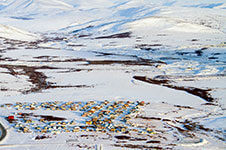In 2021, Quintillion officially launched its High Latitude Data Acquisition (HiLDA) ground station. Located in Utqiaġvik at 72 degrees latitude, 320 miles north of the Arctic Circle. We built the ground station as a US-based downlinking solution for polar-orbiting satellite operators.
It has a 3.7-meter S/X band antenna that is available for occasional use and Ground Station as a Service (GSaaS) applications. The facility also offers dedicated platform leasing bundled with a variety of services —including operations and maintenance (O&M), backhaul, colocation, power, and cloud access.
As the highest latitude ground station on US soil, the Quintillion HiLDA Ground Station offers an advantageous and secure location for American satellite operators to downlink or uplink data. This ground station was designed to serve commercial, military, and government operators.
Constructing a ground station in the Alaska Arctic was no easy feat. We faced many barriers along the way, from building and welding in harsh winter conditions, to figuring out the logistics of transporting heavy equipment to the northernmost location in the country. However, with our talented local team of Alaskans, Quintillion took on the challenge, and we leaped over every hurdle in our way.
Challenges Building the Quintillion HiLDA Ground Station
To best capture the process our engineering team and partners went through to build the HiLDA ground station, we talked to Daniel Kerschbaum, the vice president of operations and engineering at Quintillion.
“This kind of project is interesting. You’ve got a number of items. One is just the long lead times for the equipment itself. These ground station antennas and the radomes are things that aren’t just sitting on a shelf somewhere. So when you order them, it takes a while for the manufacturer just to put them together.
At the time, it had to get built and then shipped – which was quite a feat for big pieces of equipment. They were put on a ship and then sailed over to the U.S. at a port where they could be offloaded and then trucked up to Anchorage. And then we had them trucked up to Dead Horse.
That’s where some other complicating factors for this project came in. There’s really only one barge that goes up during this particular time of the summer. And if you don’t get your big equipment or freight items onto this barge, there’s only one option left – to charter a big freight plane. And that’s what we had to do for this platform and antenna. “
Building During the Polar Night in Utqiaġvik
Additionally, Daniel and the rest of the engineering team had to complete construction for the ground station in the middle of Alaska’s winter season. In Alaska’s Coastal Plain, the tundra-covered landscape makes working with heavy equipment impossible as it would get bogged down and sink. It’s not until temperatures drop and the ground freezes that construction can begin.
For Quintillion’s team, this meant building and operating in hostile, Arctic conditions. “Cold does not do well for people or machinery. Working with steel at 30 degrees below zero is not something you can do for a long time without taking a break and warming up.” Additionally, Dan remarked that they did not see the sun during the span of the project. During the winter months, Utqiaġvik enters a period of “polar night” where the sun does not rise for two months.
While these demanding conditions made building the HiLDA ground station an incredibly difficult project, the team was qualified and ready to meet these challenges. The Quintillion team had already tackled the milestone of building out a fiber optic cable system in the Alaska Arctic which involved laying 1200 miles of cable under the ocean floor from Nome to Prudhoe Bay, as well as 500 miles on land from Prudhoe to Fairbanks.
Our team had faced these environmental challenges before and had the engineering expertise and project management skills to pull it off. We also had a great network of construction partners by our side, including SKW, ASTAC, and Workwise Welding. The team succeeded in completing the construction in only a couple of months.
Highlights of Quintillion’s High Latitude Ground Station

In February 2021, the Quintillion HiLDA Ground Station was completed and has been in service since. As previously mentioned, it’s located at 72 degrees latitude and 320 miles north of the Arctic Circle. It was built in partnership with ATLAS and is the highest latitude ground station in the United States. Here are a few of the highlights of this downlinking facility.
Location
What sets the HiLDA ground station apart the most is its location. Built in Utqiaġvik, it is the highest ground station on US soil and has 360-degree visibility of the sky. From this high-latitude location, satellite operators who launch polar-orbiting satellites into orbit can see more satellite passes in a day.
This location offers significantly more passes than anywhere in the lower 48, and it offers more passes than other locations in Alaska, such as Anchorage of Fairbanks. And with each pass, operators have the opportunity to download data from satellites.
Cloud Access
From the ground station, operators have the choice to utilize the Equinix data center in Seattle. In addition to offering colocation services, operators can also connect to cloud providers and other third-party companies to scale their operations if they don’t already have a data processing solution.
Antenna Interface
Through ATLAS, satellite operators can utilize an interface to schedule satellite passes and pick up data. With this interface, a large number of integrated ground stations across the country can be accessed. Therefore, operators are not only able to schedule passes at Quintillion’s HiLDA location, but also at other locations around the globe where they pay for ground station services. This enables operators to increase the number of passes they process a day, diversify the times and locations of those passes, and pick up different types of satellites (such as geostationary or highly elliptical orbiting satellites).
Security
The remoteness ofUtqiaġvik is another natural advantage of its location. It’s not an area anyone can readily access, which provides a layer of security for the satellite data being retrieved and processed. Additionally, the HiLDA ground station has several stringent security standards in place, including cameras and 24/7 monitoring, data encryption, and a local presence that can respond and do maintenance checks.
Expandability
The location of the HiLDA Ground Station offers several opportunities for scalability. Currently, we are building two platforms that will allow customers to operate on Ka and Ku bands, in addition to putting out additional S and X bands. We also have multiple options for expansions that are adjacent to our facility.
Choose the Quintillion HiLDA Ground Station for Your Satellite Operation
Until the launch of the HiLDA Ground Station, satellite operators have been faced with two choices: to downlink to a facility in a different country, or use a low-latitude ground station. The Quintillion HiLDA Ground Station closes critical security gaps by reducing reliance on foreign entities for processing satellite data and providing a diversified backup point at the most remote place in the United States.
Looking for a secure downlinking solution for your polar-orbiting satellite operation? Learn more about our GSaaS capabilities antenna pad leasing.















